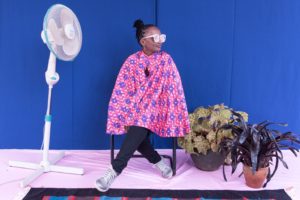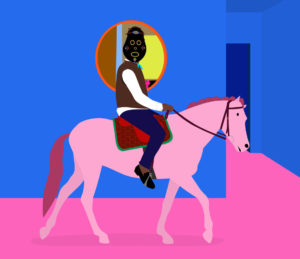
Two artists from different generations, different parts of the continent but speaking the same language- pop! Their union was lively one, a much-needed one for a scene that is not used to such vibrancy.
Artist and critic Matt Kayem on the Afro-Pop of Evans Mbugua and Dennis Osadebe
Dennis Osadebe, Gentleman on a Hors Indoors, 2018
Evans Mbugua and Dennis Osadebe : A Spectacular Now
The twelve year age difference couldn’t even stop these two artists from showing together in a two-man show at Circle art gallery in Nairobi. Two artists from different generations, different parts of the continent but speaking the same language- pop! Their union was lively one, a much-needed one for a scene that is not used to such vibrancy. Looking around Nairobi creatives, one cannot simply fail to notice and point out the predominant leaden palette among the art. From the greys and blacks of Paul Onditi and Peterson Kamwathi to the earthly browns and reds of the Maasai Mbili collective; the blocks of bright yellows, greens and blues at this show were like a red drop in milk. But at the same time, maybe vibrancy and color is not new for a city with the popular matatu art. When you enter the city, you are welcomed with beautifully painted taxi vans and buses commonly known as matatus.
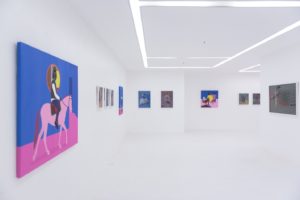
Installation view of the exhibition.
His first show on home turf for the returnee, Mbugua couldn’t hide his excitement and gratitude as he swerved around the exhibition room, entertaining different guests during the opening reception. He would later confess to me in one of our conversations how he had ticked this off his bucket list. Born in Nairobi, Evans left for France in 1999 for art education. Since then, he has been coming in and out of his home country but not engaging with the local industry. He has however built a successful career outside, from Art X Lagos to 1:54 Contemporary African Art Fair and many other achievements to his name. Osadebe on the other hand is a much younger artist but also tested some of the successes of the contemporary art world. He also has acquired education from Europe as he holds a BSC in Business and Management from Queen Mary University of London and other credentials which are surprisingly not related to art. Dennis is a self-taught artist who has been working since 2013.
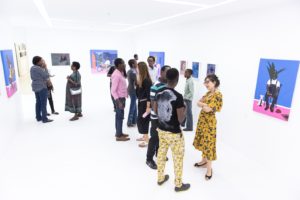
Mbugua(closest to the camera) attending to guests at the show.
Circle art gallery, the venue for the exhibition provided a wonderful space for the show which was in sync with the work. Its clean white cube agreed well with the smart technically competent work of the two artists in a show that might be the cleanest Nairobi has ever seen. There is a need to have more spaces like Circle in East Africa for the masses to value the art. “My goal was to present art in a world-class manner” were the words of the director of Circle, Danda Jaroljmek. As a self-proclaimed art critic deeply interested in the commercialization of art, mine has been to look for spaces and persons that share the same vision and Circle art gallery is a real game changer. With an industry like the East African one where art is undervalued and the general public disinterested, structures like Circle are meant to make them think twice. It’s an interesting scenario comparing the art world globally. The west is fed of the over-commercialization of art and white cubes but places like East Africa are at the opposite, fighting for people to accept and take the field seriously.
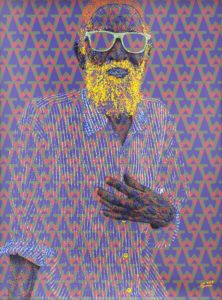
Evans Mbugua, Your Captain, 2018.
What makes the meeting of these two artists successful? Both of them are deeply fascinated with the everyday, the couch, the basketball, portraiture, simple things that they use to convey complex messages and emotions. If we were talking movements, they probably could belong to one called “Afro-Pop” but since Dennis is already fronting his, called “Neo-Africa”, he would do rather stay in it. Osadebe has long been frustrated by the limiting label, “African art” that gets slapped on the work of artists with connections to the continent. He thinks it’s a lazy and tired categorization, one that places unreasonable expectations upon African artists. These sentiments form the basis of his philosophy and I see them openly projected through his work when he borrows from western culture with the environments and puts an ‘African’ mask to the protagonist in the artwork. Dennis’ work and particularly Hoop Dreams reminds me of Richard Hamilton’s Just what is it that makes today’s homes so different, so appealing? Maybe it’s in the composition or the cut-out effect Dennis’ work possess in comparison to the manual collage of Richard Hamilton.
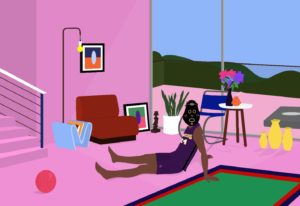
Dennis Osadebe, Hoop Dreams, 2018.
Whereas the gravity in Mbugua’s work can be found in his technique, for his show-mate, the complexity lies in his concept and compositions. The most common question on the mouths of those that interacted with Mbugua’s work was, “How does he do it?” Mbugua’s work comprises of a patterned background layered on top with a figure in dots. He uses the dots of oil paint to build human figures on Perspex. The background behind is digitally developed and inspired from everyday signage and iconography. The background also borrows back from the infamous Dutch-wax print. The points he scores now here is that the print is originally his conception, you will never see it anywhere else. Evan’s technique therefore goes on to indicate that he is a skilled draughtsman as the creation of the work allows for little or no erasure. His work also shows a great understanding of the human anatomy and color. The subjects in Mbugua’s work are people he’s known and met, people whose stories have impacted him positively. So he chooses to celebrate them this way by painting them.
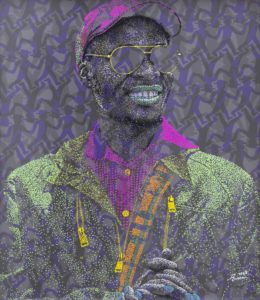
Evans Mbugua, Pamoja, 2018.
Osadebe’s work strikes the viewer with its pared down blocks and elements of bold color. He largely employs digital processes to create his work which he often finishes with a few touches of acrylic paint in specific areas to render the work a unique piece. You can’t escape the wit, provocation and juxtaposition in a bid to invite viewers to critically think about their world and their place within it. The mask which alludes to traditional cultural practices in his native Nigeria appears in a modern setting. The titles, hip and slangish, reminding you that the artist belongs to the age of millennials. One with a masked figure sitted faces the viewer reading “Still Life With Some Dude”. Talk about including the young people to the old people club of high art.
The works have a lot of play with art history and centering the narrative around Nigerian’s art and culture. The repetition of the mask in the all works make it the centre of the narrative. Osadebe hopes to shift the negative stereotype painted about Nigeria and recreate the true reality of the Nigerian that can be engaged with today, which is full of aspiration and exposure as a result of access to the internet.
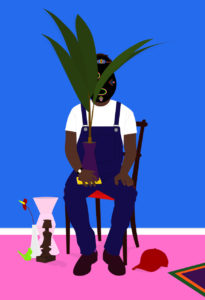
Dennis Osadebe, Still Life With Some Dude.
The photo installation outside the gallery was like the dessert to the main course in the gallery. A blue background and a patterned cloth laid down where guests had to pose in Mbugua’s printed jackets and spectacles for a photograph. The installation was merging both of the artists ideas, Mbugua’s patterns with the jackets and spectacles and Dennis’ one color backgrounds and the fan. It was all fun as the guests took turns, wore the costumes and felt like the artists’ muses.
